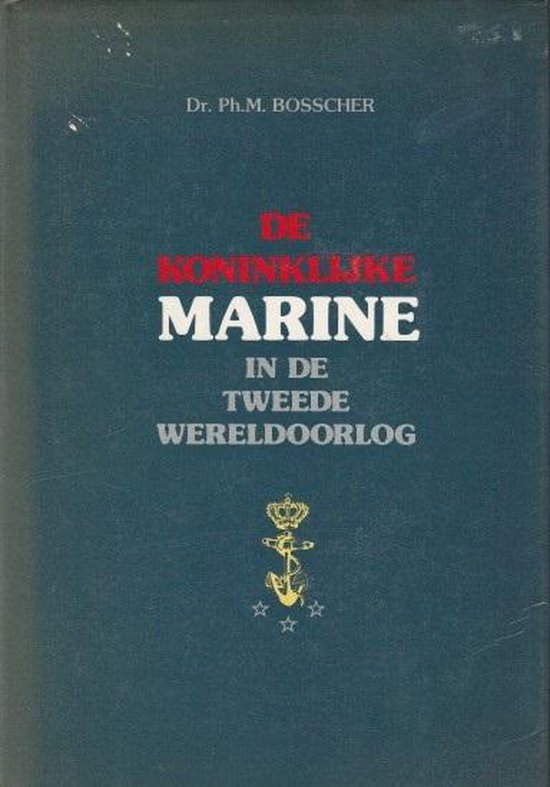Preface
Seldom an unequal battle, like the one between the Dutch oil tanker Ondina escorted by the British Indian corvette HMIS Bengal, and two heavily armored Japanese auxiliary cruisers has ended up in such unexpected way. One of the Japanese raiders was sunk and the two allied ships, in spite of everything, reached safe harbors. The heroic battle of the Ondina and the Bengal already created the necessary sensation during the Second World War and till today it is an example of courage and perseverance of both merchant navy personnel as well as of military seamen.
German auxiliary cruisers or Hilfkreuzer, merchant ships converted into war ships, were used in the beginning of the Second World War as privateers against enemy merchant ships as Handelsstörkreuzer [trading-disturbing-cruisers]. The British called such auxiliary cruisers “Armed Merchant Cruisers” (AMCs) and the ones that were operated against merchant ships were called “surface raiders”. The German raiders were very successful in disturbing the trans-oceanic supply lines of the British by sinking thousands of tons of allied ships’ capacity. The most successful German raider was the “Pinguin”, which sank or captured 28 allied merchant ships with a total capacity of over 154,000 ton, before the ship disappeared beneath the waves of the Indian Ocean, foundered by the British cruiser HMS Cornwall. Early 1942 all German raiders had been sunk or were on their way back to Germany.
The Japanese did not so much recognize the strategic necessity of disturbing supply lines of the allies, at least not in the sense the Germans did. They had been irritated however by the presence of the German raiders in the Indian Ocean, which they considered to be their home turf. But nevertheless they began to become concerned about the allied tankers that transported costly oil products from the beginning of 1942 almost undisturbed from the Middle East to Australia. In order to prevent the Germans from utilizing new raiders in what they considered to be their maritime territory and in order to interrupt the allied oil provisioning, they decided to engage a number of surface raiders themselves.
They utilized therefore some fourteen freighters with passenger accommodation and converted those into auxiliary cruisers. The Japanese raiders however appeared not to be as successful as their German counter parts because the Japanese lacked experience with this type of sea warfare. Apart from that, the Japanese raiders did not stay out on sea for a long period of time, something the German Handelsstörkreuzer did. The German raider Atlantis for example stayed out at sea for 602 days continuously and captured or sank during this time 23 allied ships with a total capacity of 145,000 ton. Also the Japanese committed always several pirate ships at the same time as they were afraid to loose them. This was of course not so clever as the success of the privateer depended on the element of surprise, disguise and deception. Two or more auxiliary cruisers together were always suspect in the eyes of a potential victim.
On November 11, 1942, the heading of two Japanese surface raiders crossed that of a Dutch oil tanker and a British corvette. The allied ships attacked the heavily armed Japanese auxiliary cruisers and were in all aspects in a disadvantageous position. The battle would however provide a totally unexpected result.
Images
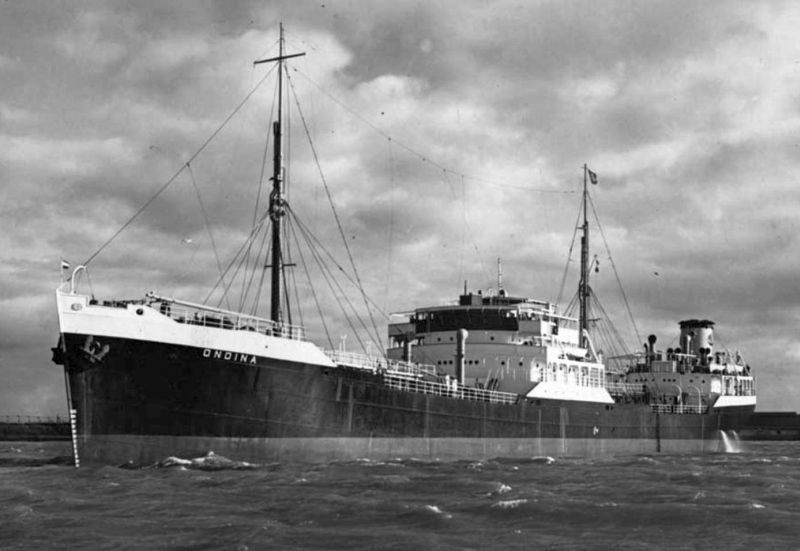 The Dutch tanker Ondina in 1939. Source: Maritiem Museum Rotterdam.
The Dutch tanker Ondina in 1939. Source: Maritiem Museum Rotterdam.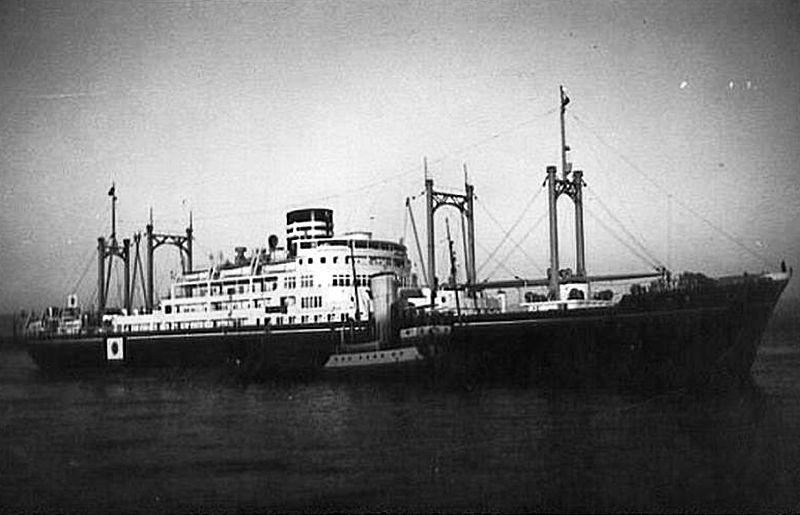 Hokoku Maru before the Second World War. Source: Photoship.
Hokoku Maru before the Second World War. Source: Photoship.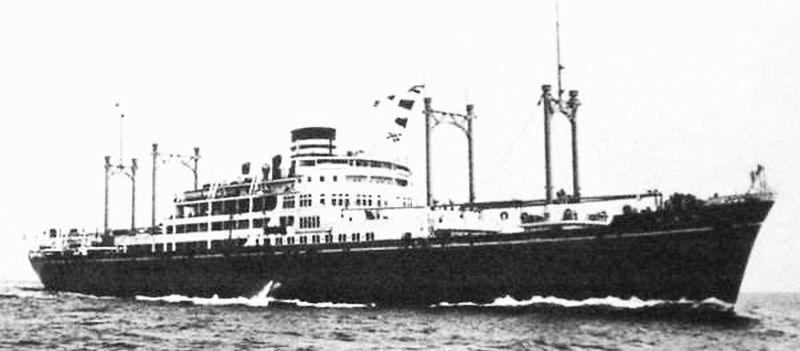 OSK-liner Aikoku Maru in 1940. Source: Combinedfleet.
OSK-liner Aikoku Maru in 1940. Source: Combinedfleet.The Japanese auxiliary cruisers Aikoku Maru and Hokoku Maru
In 1940 the cargo ships with passenger accommodation of the Osaka Shosen KK [Osaka shipping line] Aikoku Maru and Hokoku Maru were requisitioned in order to be converted into auxiliary cruisers. The reconstruction started in 1941 at the shipyard where originally their keel had been laid, the Tama Zoshenso KK [Tama Shipbuilding Corporation] in Okajima. The ships of 10,437 ton were provided with four 15cm, two 8cm and four 2.5cm guns, two double torpedo launching tubes and two Kawanishi E7K type 94 float planes (allied code name Alf). The ships were equipped with two 12-cylinder Mitsubishi-Bürmeister & Wain diesel engines of 13,000 shp which enabled a top speed of 21 knots. From December 1941, the auxiliary cruisers were mainly committed to escorting convoys and only seldom to cargo ship privateering. On 12 December 1941, Aikoku Maru and Hokoku Maru sank the old American freighter Vincent. Eleven days later the crew of the American merchant ship Malama scuttled their own vessel after it had been threatened to be bombed by a float plane of the Aikoku Maru. The ship was carrying army trucks and aircraft engines and the captain did not want to run the risk that his costly cargo would end up in Japanese hands.
In February 1942 the Aikoku Maru and the Hokoku Maru received eight modern 14cm guns at the Kure Navy Yard, the most important warship yard in Japan. The four 15cm guns, which dated back to the Russian Japanese war in 1905, were removed. Furthermore the two Kawanishi amphibian aircraft were replaced by two faster Mitsubishi F1M Type 0 float planes (allied code name Pete). On May 9th, 1942, during the second pirating mission of the auxiliary cruisers they captured the 7,987 ton tanker Genota of La Corona, a daughter company of Shell. The tanker was sent to Singapore with a prize crew and started sailing under the Japanese flag as captured ship.
Early June 1942 Aikoku Maru and Hokoku Maru were sent to Mozambique Strait as depot ships for the Japanese submarines present in that area and as privateers. Between 5 June and 13 July the submarines sank 21 allied freighters and tankers with a total capacity of 92,500 ton. Both the auxiliary cruisers foundered the British Elysia of 6,757 ton on June 5th and captured the New-Zealand ship Hauraki on 12 July. This was a very meager result compared with the success of the German surface raiders.
On 5 November, 1942, Aikoku Maru and Hokoku Maru were sent on a privateer mission again and departed on that day from Singapore. The commander of the Hokoku Maru, Tai-sa [Captain] Imazato Hiroshi was in charge of both vessels being the senior officer. Commander of Aikoku Maru was Tai-sa Tamotsu Oishi. This fourth mission would generate many more consequences for both Japanese auxiliary cruisers rather than only a little success.
Definitielijst
- torpedo
- A weapon of war. A cigar shaped body fitted with explosives and a propulsion and control mechanism. Intended to target after launch a nearby enemy ship and disable it by underwater explosion.
Images
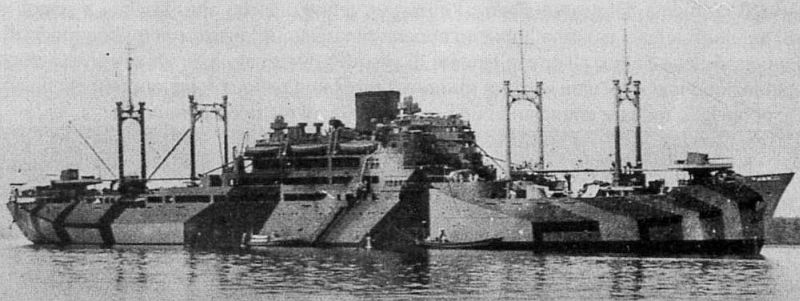 Aikoku Maru in Singapore, 1942. Source: Combinedfleet.
Aikoku Maru in Singapore, 1942. Source: Combinedfleet.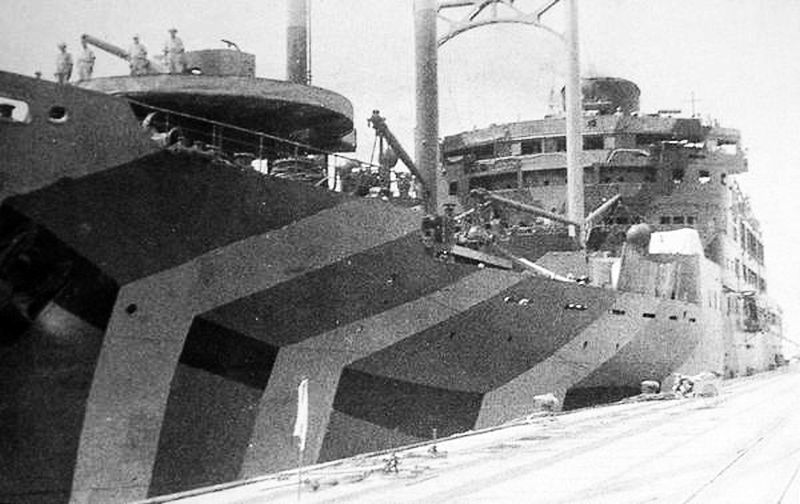 Hokoku Maru in 1942. Source: Wikipedia.
Hokoku Maru in 1942. Source: Wikipedia.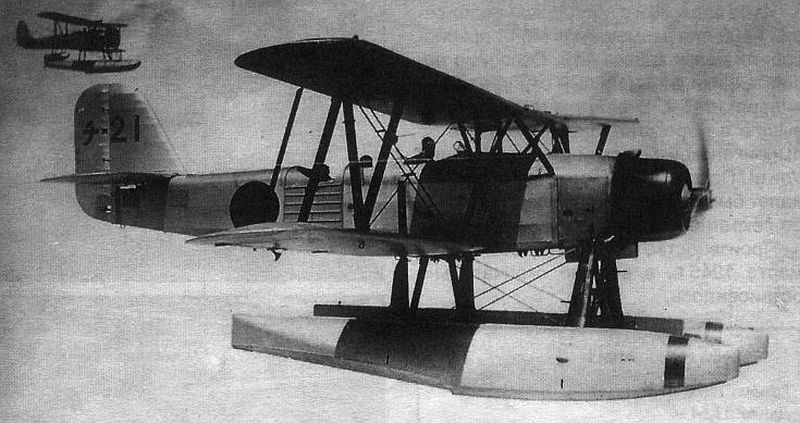 A Kawanishi E7K amphibian aircraft. Source: Wikipedia.
A Kawanishi E7K amphibian aircraft. Source: Wikipedia.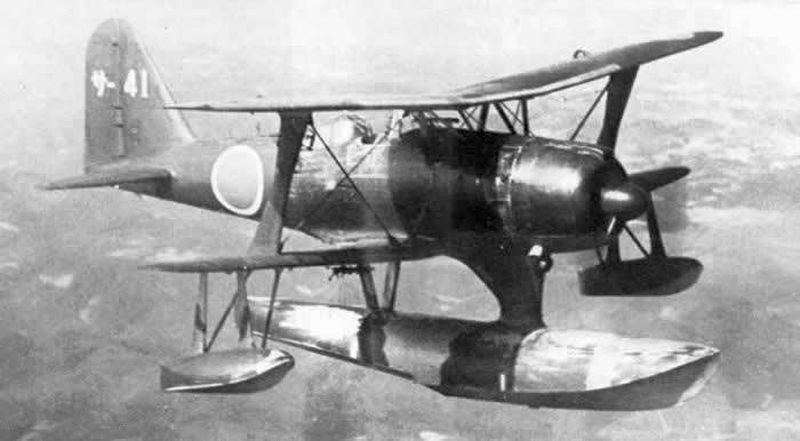 The Mitsubishi F1M float planes on board of the Hokoku Maru were destroyed. Source: Wikipedia.
The Mitsubishi F1M float planes on board of the Hokoku Maru were destroyed. Source: Wikipedia.The Ondina and HMIS Bengal
The motor vessel Ondina was a modern Dutch tanker of the Petroleum Company La Corona and had been delivered by the Dutch Dry Dock Company in Amsterdam [Amsterdamse Droogdok Maatschappij ADM]. The tanker had an overall length of 130 meters and a standard displacement of 6,341 ton and was equipped with a 6 cylinder Werkspoor diesel engine with a modest power supply of 2,800 shp. The maximum speed of the Ondina therefor was only 12 knots. The maiden trip of the Ondina, which started in December 1939 was already a very special one. The tanker, under the command of captain K. van der Kooi, had to load in the USA in five different ports, five different types of lubricating oil to be delivered to Great Britain. For security reasons and on his own initiative, he joined a British-French convoy which left from the East Canadian port Halifax and the Ondina arrived safely in Great Britain. The Dutch government became very much embarrassed herewith as the Netherlands were still neutral at that time. They were therefor not very grateful to captain Van der Kooi as he had endangered the position of the Netherlands. As he had safely delivered his cargo and because the Dutch government recognized that he had been motivated by his concern about his ship, crew and cargo it all blew over and his employer received a warning.
During the first years of the Second World War the tankers of La Corona, and therefor also the Ondina, continued to carry oil products, but no longer to and from Europe. The tankers were equipped with a gun and some anti-aircraft machine guns. The Ondina was provided with an American 10.2 cm gun which was placed on the poop deck, with 40 pieces of ammunition and a few machine guns. Early November 1942 the Dutch tanker was moored in Fremantle, at the Australian west coast, after having discharged a cargo of oil products. Next destination was Abadan in Persia, presently Iran, in the Persian Gulf. The tanker loaded several hundreds of tons of grain as ballast. In Fremantle 33 year old Willem Horsman became the new captain of the Ondina. The other officers on board had also the Dutch nationality, but the remainder of the crew consisted of Chinese. Most gunners aboard the Ondina were British and Australian naval personnel. The Ondina also carried with her a straggler in the person of Able Bodied Seaman Henry of the Royal Navy, who actually belonged to the crew of HMIS Bengal. He showed up too late in the harbor of Fremantle to be able to embark on his ship which had left just before the Ondina. The Australian Navy had put him aboard the Ondina and it was the intention that he would change over to his own ship as soon as there was an opportunity. In total there was a crew of 56 aboard the Ondina.
The Ondina was for a long way going to be escorted by the new Bathurst-class corvette HMIS Bengal, which was destined for the British Indian Navy. During the Second World War 60 of these ships were constructed after an Australian design. Four of these corvettes, often called minesweepers as they were equipped with minesweeping equipment, had been built in the framework of the ’Commonwealth’s Shipbuilding Programme’ for the Indian Navy. British India at that time was still a British colony and therefore automatically a member of the Commonwealth. The four ships built for India were HMIS Madras, HMIS Punjab, HMIS Bombay and HMIS Bengal. This last ship was taken into service on 8 August, 1942, by Lieutenant Commander W.J. Wilson of the Royal Navy Reserve (RNR).
The corvettes of the Bathurst-class originally had a standard displacement of 650 ton but during the war the vessels were loaded with masses of extra equipment, ammunition and depth charges; so fully equipped they had a displacement of over 1,000 ton. The ships were provided with a triple expansion steam engine which supplied 2,000 shp. The max speed of the corvettes was designed to be 15 knots, but because of the larger displacement most of them did not go faster than 13 knots. On HMIS Bengal a 7.6cm gun (twelve pounder) had been installed as the foreseen 10.2cm guns were no longer in stock. The secondary armament of the ship consisted of a 40mm Bofors and two 20mm Oerlikon machine guns as anti-aircraft weapons. For the anti-submarine warfare the multi-purpose vessel was equipped with a type 38 Asdic (fore runner of the sonar) and 40 depth charges.
As the Bengal had only a capacity of 186 tons of heavy liquid fuel oil she could not reach India in one go from the Australian mainland. But sailing together, the ships would serve each other: the Ondina received an escort for part of the trip and HMIS Bengal could obtain fuel from the Dutch tank ship. It was scheduled that the Ondina and the Bengal would split up at Diego Garcia on the Chagos Archipellago south of the Maldives. On 5 November, 1942, the two allied ships departed from Fremantle. With an average speed of 10 knots it promised to be a long and dull crossing.
Definitielijst
- Asdic
- Short for Allied Submarine Detection Investigation Committee. British system used to detect submerged German U-boats. ASDIC emitted an electronic signal and caught the echo and transformed it into sound, the famous ”ping”. ASDIC only had a range of 1.5 nautical miles and it took an experienced operator to distinguish a submarine from a shoal of fish.
- Commonwealth
- Intergovernmental organisation of independent states in the former British Empire. A bomber crew could include an English pilot, a Welsh navigator, air gunners from Australia or New Zealand. There were also non-commonwealth Poles and Czechs in Bomber Command.
Images
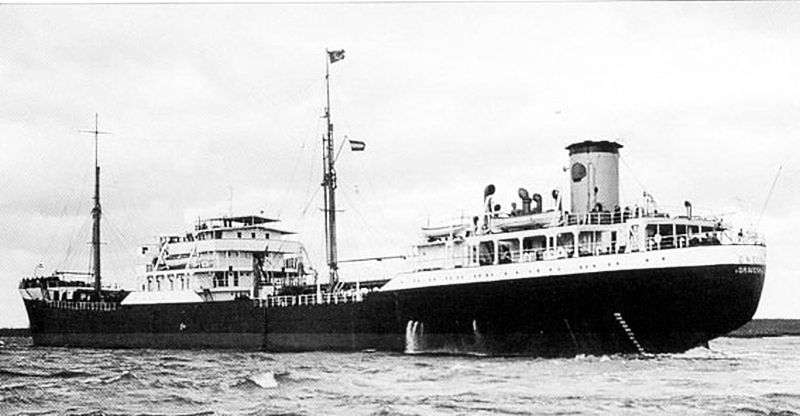 The Ondina in 1939. Source: Kombuispraat.
The Ondina in 1939. Source: Kombuispraat.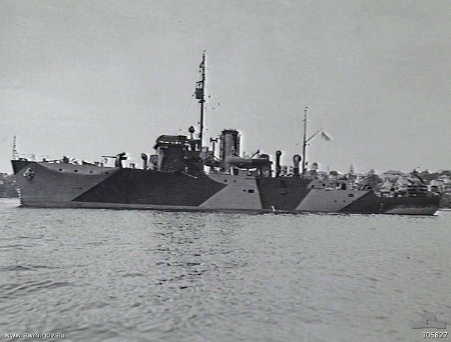 Of HMIS Bengal no photographs are available. This is a picture of her sister ship HMIS Bombay. Source: Australian War Memorial.
Of HMIS Bengal no photographs are available. This is a picture of her sister ship HMIS Bombay. Source: Australian War Memorial.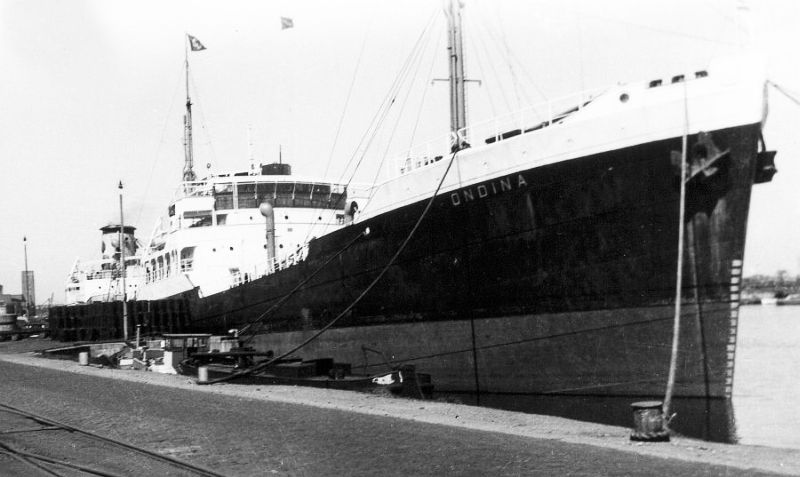 The Ondina before WW2. Source: Kombuispraat.
The Ondina before WW2. Source: Kombuispraat.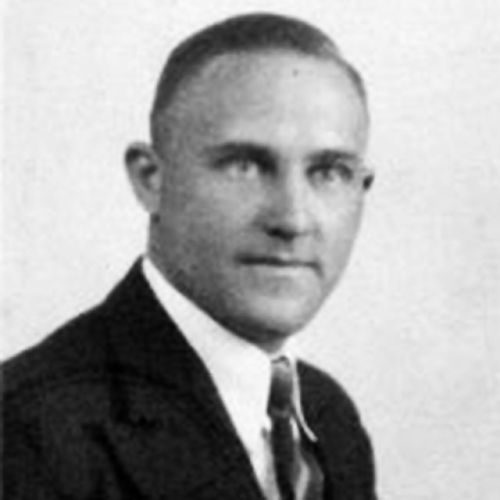 Captain Willem Horsman. Source: Lytjepole.
Captain Willem Horsman. Source: Lytjepole.The battle
In the morning of 11 November, 1942, HMIS Bengal and the Ondina sailed in line ahead, heading west-north-west. It was a nice and sunny day with a flat sea and excellent visibility. Around 11:30 a lookout of the Ondina saw two ships appear over the horizon at 90 degrees over port at a distance of approximately 12,000 meters. A little bit later the ships were also sighted from the Bengal. Because of the high deckhouses the strange ships for a moment were taken to be aircraft carriers. Because there had been no mentioning at all about allied ships being in the neighborhood, both Ondina and Bengal sounded the alarm and both ships turned 90 degrees to starboard, away from the suspected enemy ships. Around 11:50 Bengal signaled to Ondina to maintain her heading. The Bengal herself turned into the opposite direction in order to catch up head on with the enemy ships and to create time for Ondina to escape.
The enemy ships were recognized to be Japanese auxiliary cruisers and the Bengal steamed straight forward towards the one in front. First they thought that they were facing Hokoku Maru and the smaller Kunikawa Maru (1937). Captain Horsman understood that he would never be able to pick up sufficient speed with his slow tanker to escape from the faster Japanese vessels and decided to face the battle and to support the Bengal with his 10.2cm gun. Just before 12:00 Hokoku Maru opened fire at HMIS Bengal and at 11:58 the corvette send an SOS signal to Fremantle with the message that they and the Ondina were under fire of two Japanese raiders in the position of 19.38 degrees southern latitude and 93.5 degrees eastern longitude, about half way Fremantle and the Chagos Archipellago. HMIS Bengal answered the fire of the Hokoku Maru with her twelve pounder. Second mate Bakker of the Ondina, who was the artillery commander of the tanker and was standing on the poop deck next to the gun, asked permission from captain Horsman to open fire. Steaming away from the approaching Japanese auxiliary cruisers, the captain of the Ondina granted permission. The artillery crew consisted of merchant seaman Visser, Able Seaman B.A. Hammond of the Royal Australian Navy and the Acting Able Bodied Seamen R.H. Bayliss, H.C. Boyce and H.A. Brooklyn of the Royal Navy. The Ondina opened fire when the Hokoku Maru had approached till about 8.000 meters, around 12:05. While the Dutch tanker received her first 14cm hit, which splintered the mast, the first 10.2cm shell of the Ondina went wide and the second hit just in front of the bow of the Japanese auxiliary cruiser. Therewith Second Mate Bakker could adjust his fire and the third grenade hit the deckhouse of the enemy ship. This was an extra ordinary achievement as the Ondina was not equipped with distance measuring equipment nor with fire-guidance. Bakker now diverted his fire to the stern of the Hokoku Maru. Whilst both HMIS Bengal as the Hokoku Maru continued to shoot at each other the fifth or sixth shot of the Ondina caused an enormous explosion on the Japanese auxiliary cruiser. A giant yellowish flame erupted and soon thereafter part of the stern broke off while the wrecked float planes shattered into the sea. The broken part of the rear of the ship sank and wild fires broke out in various places onboard the ship. Thereafter the ship listed heavily to starboard which caused ammunition to roll over and even more explosions erupted.
Aboard the Ondina they could not believe their ears and eyes The artillery crew danced for joy in spite of the fact that some enemy shells hit which damaged the radio antenna and one of the starboard life boats. The Chinese crew members who were not on duty, had sought a safe refuge below deck and AB Seaman Henry did his utmost to keep them composed. The Aikoku Maru now took aim on both ships and placed several hits on both ships that caused little damage though. When the Bengal ran out of ammunition the corvette put up a smoke screen and turned away from the battle around 12:40. One minute later the Bengal was hit again; this time in the rear which caused a fire to start. The crew of the corvette however succeeded to control the fire. The last they saw of the Ondina aboard the Bengal was that the tanker received a hit on the bridge at 13:08 and desperately tried to prevent further hits by changing course all the time a little bit. The corvette after having seen this, sent a coded message with the information that one of the auxiliary cruisers as well as the tanker had been sunk.
Aboard the Hokoku Maru the crew could not control the heavy fires and Commander Hiroshi could do nothing else but to issue the order to abandon ship. In the meantime on board all electrical power had failed and the engine rooms were ablaze. Because the Hokoku Maru was a converted merchant ship she did not have many watertight compartments; consequently the vessel made quickly a lot of water and after another heavy explosion the auxiliary cruiser foundered at 13:12. Of the 354 crew 76 lost their lives amongst whom Captain Hiroshi.
In the meantime Ondina had fired her last 10.2cm shells whilst the Aikoku Maru had closed in on the tanker up to approximately 3.500 meters. Captain Horsman ordered white flags to be hoisted and ordered to abandon ship. The engines had stopped and the crew disembarked the ship in three life boats and two life rafts. The hit that struck the Ondina at 13:08 on her bridge, the last to be seen by the Bengal, killed captain Horsman. The remaining Japanese raider approached the Ondina up till 400 yards and launched two torpedoes towards the abandoned ship that both hit. Large holes were blasted in the starboard side of tanks number 1 and 2. This caused the Ondina to list to about thirty degrees, but remained floating on the other tanks. Thereafter the auxiliary cruiser maneuvered along the bow of the tanker, of which the Japanese thought that its fate had been sealed and started to machine gun the life boats and rafts. This war crime was probably committed out of frustration about the sinking of the Hokoku Maru and the escape of the Bengal. By this machine gunning three Chinese stokers were killed and the chief engineer J.J. Niekerk and ABS Henry were severely wounded. Chief engineer Niekerk died an hour afterwards from his wounds.
At 15:00 the Aikoku Maru had picked up the survivors of her sister ship and returned to the Dutch tanker. The Japanese fired another torpedo but missed. Convinced that the tanker had been lost, the Japanese auxiliary cruiser left the battle scene and sailed away in northerly direction without any further concern about the drowning crew of the Ondina.
Definitielijst
- machine gun
- Machine gun, an automatic heavy quick firearm.
- torpedo
- A weapon of war. A cigar shaped body fitted with explosives and a propulsion and control mechanism. Intended to target after launch a nearby enemy ship and disable it by underwater explosion.
Images
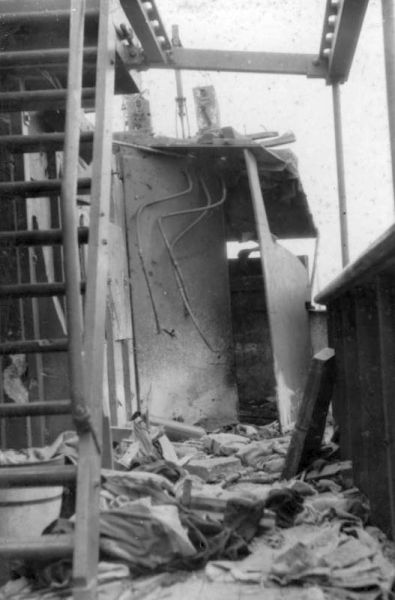 Damage on board of the Ondina. Source: Maritiem digitaal.
Damage on board of the Ondina. Source: Maritiem digitaal.Salvage of the Ondina
After the first mate Rehwinkel had provided a seaman’s grave to the chief engineer, he wanted to return to the Ondina. Of the crewmembers that were with him in the life boat only sailor Visser was prepared to accompany him. The others, Chinese crew members refused to come along as they feared that the Ondina would sink as yet. Second mate Bakker in the meantime, with the motor launch in which he was commander, had returned to the tanker. Together with third engineer Leys, the Australian gunner Hammond and the British artillerist Ryan he boarded the ship which was still on fire in several places. Bakker and the gunners started to pump water into several of the port tanks which slowly righted the Ondina. Leys inspected the engine room and established that the diesel engine was still in working condition. The motor launch was sent to collect the other life boats and rafts and Leys and Bakker went to the bridge where a fire was still burning. The fire was extinguished by both men after which they carried the body of the captain to his cabin. The tanker had in the meantime been righted and the outboard valves could be closed. Around 19:00 all life boats were alongside the tanker and the crews from the rafts had been taken aboard the life boats. The life boats were hoisted on board as good and as bad as this was possible and secured. The stokers and engineers went to work and a few hours later first officer Rehwinkel could give the order ”slow ahead”. And somewhat later even “full ahead”. The heavily damaged tanker set her heading for Fremantle while the crew extinguished the last fires in the forecastle.
The next day captain Horsman received a dignified seaman’s burial. The wounded were cause for serious worry. Especially ABS Henry was in serious condition. He had a crushed leg and had lost a lot of blood and was in urgent need of professional care. After two days the crew of the Ondina was of the opinion to be safe enough to send a radio message and to ask for medical assistance. This message was sent in clear language as, after the order to abandon ship, all secret documents and also the code book had been thrown overboard. The surprising and unexpected message was being received by the allied authorities in Colombo on Ceylon and in Fremantle with disbelieve and mistrust. As the Bengal had indeed reported the Ondina to be sunk and a trap, created by the Japanese in order to lure a ship towards them, was suspected. From Fremantle a signal was sent to inquire about her position. Rehwinkel did not dare to provide this because his clear language message could also be read by the enemy. Therefore medical assistance remained lacking for the time being.
It was not until 17 November before the damaged tanker was reconnoitered by an Australian Catalina flying boat, over 220 nm north-west of Fremantle. Onboard the Ondina shortly before, a ship had been spotted and with signal lamp the Catalina was asked to contact that ship and to ask for the presence of a doctor. The relevant ship turned out to be the Australian hospital ship HMAS Wanganella and it was directed quickly towards the Ondina. By quick handling of the doctors the life of ABS Henry could be saved. The next day the Dutch tanker entered the port of Fremantle after a trip that had not proceeded according to expectations and which had cost the lives of five crew. The day before HMIS Bengal had safely made the harbor of Diego Garcia. The last days the corvette had to sail at slow speed to safe fuel, but there had been no further problems.
Images
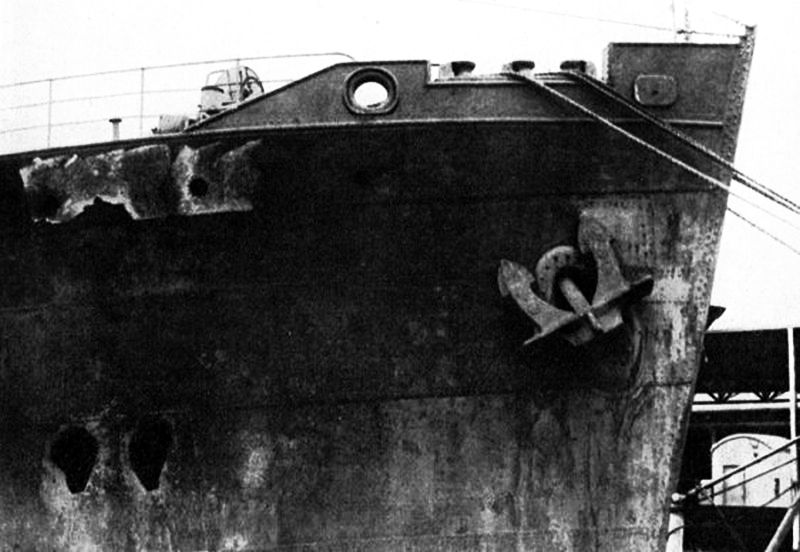 In spite of the damage the Ondina arrived safe and sound in Fremantle. Source: Kombuispraat.
In spite of the damage the Ondina arrived safe and sound in Fremantle. Source: Kombuispraat.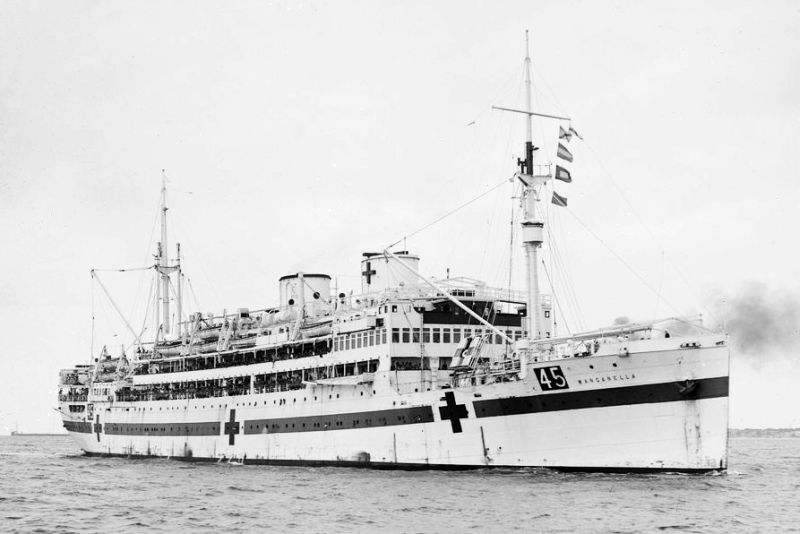 HMAS Wanganella took over the wounded from the Ondina. Source: Wikipedia.
HMAS Wanganella took over the wounded from the Ondina. Source: Wikipedia.Aftermath
The Ondina was provisionally repaired in Fremantle and served for some time as a fuel dump for Dutch submarines that were stationed in the West-Australian harbor. In 1943 the tanker was completely repaired and spent the rest of the war transporting oil products for the allied forces. HMIS Bengal was repaired in Bombay and served as an escort vessel in Indian waters. The corvette was laid up in 1960 and sold as scrap. The Ondina was the first tanker of La Corona that entered the port of Rotterdam after the liberation of the Netherlands.
On November 8th ,1948, the Ondina was moored at the Parkkade in Rotterdam and Queen Juliana and Prince Bernhard visited the ship which had become famous in the meantime. The Ondina had been awarded a Royal Citation in a Day Order and on November 8th the text of that award was read by Her Majesty the Queen. Thereafter Prince Bernhard revealed a bronze plaque with the award, which had been imparted to the ship and her crew, on the back side of the bridge . When in 1959 the tanker was laid up, the memorial plaque was mounted in the main building of Shell Tankers. Many crew members of the Ondina were personally decorated. Captain Horsman and chief engineer Niekerk posthumously. The Ondina was scrapped in 1959.
The unexpected result of the battle between the Ondina and the Bengal on the one side and the two auxiliary cruisers on the other side was tactically an allied victory. The result however had also a great strategic impact. After the foundering of the Hokoku Maru no surface raiders were committed anymore by the Japanese and the allied tankers on the routes from the Middle East to Australia were left alone. The auxiliary cruisers were reconstructed into fast, armed transports. The Aikoku Maru was sunk by American bombers in 1944 during Operation Hailstone, the demolition of the Japanese naval base on Truk.
The battle of the Ondina and HMIS Bengal was widely discussed and advertised in Australia, Great Britain and especially in the United States. The crew of the Bengal however claimed to have fired the decisive hit on the Hokoku Maru, while the crew of the Ondina was absolutely convinced that they had sealed the fate of the Japanese auxiliary cruiser. For political reasons the honor of the foundering of the Japanese vessel was allotted to HMIS Bengal. The British could employ the martial exploit very well for propaganda in the turbulent colony which was impatiently striving for independence. In the Japanese report about the battle with the two allied ships however it said: “A shell of the tanker hit the starboard torpedo tube of the Hokoku Maru and blew up a torpedo. The rear part of the ship alighted, which as a result of the herewith caused explosions, foundered.”
In fact it does not matter so much whether the Ondina or HMIS Bengal fired the fatal shot which had such disastrous consequences for the Hokoku Maru. Both ships had fought a courageous battle against heavy odds. The heroic characteristic of the battle was not the destruction of the Japanese auxiliary cruiser, that was only consequential of a lucky hit which caused a chain reaction. The heroism of the fight was the fact that both allied ships had the courage to engage in the battle with Japanese auxiliary cruisers. Attack appeared to be the best defense and because auxiliary cruisers are vulnerable, and an almost empty tanker is virtually unsinkable, the result was favorable for the Ondina and the Bengal.
Definitielijst
- propaganda
- Often misleading information used to gain support among supporters or to gain support. Often used to accomplish ideas and political goals.
- torpedo
- A weapon of war. A cigar shaped body fitted with explosives and a propulsion and control mechanism. Intended to target after launch a nearby enemy ship and disable it by underwater explosion.
Images
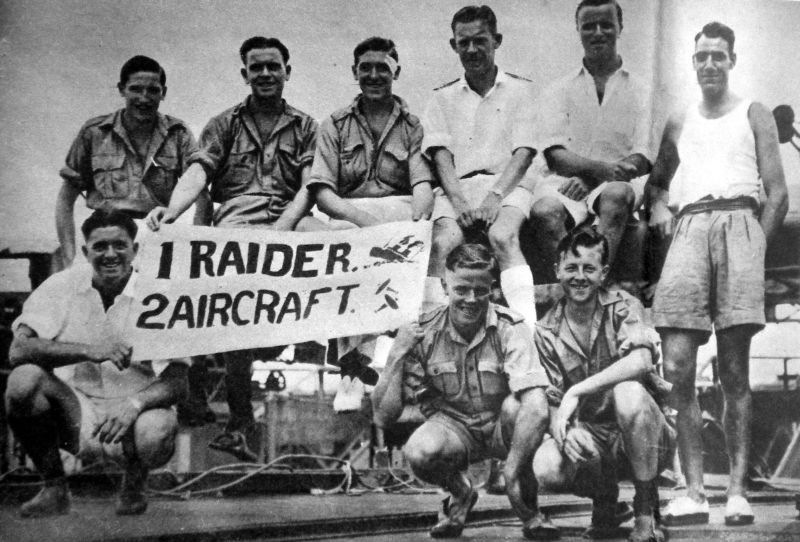 The proud artillery crew of the Ondina. The banner speaks for itself. Source: Australian War Memorial.
The proud artillery crew of the Ondina. The banner speaks for itself. Source: Australian War Memorial.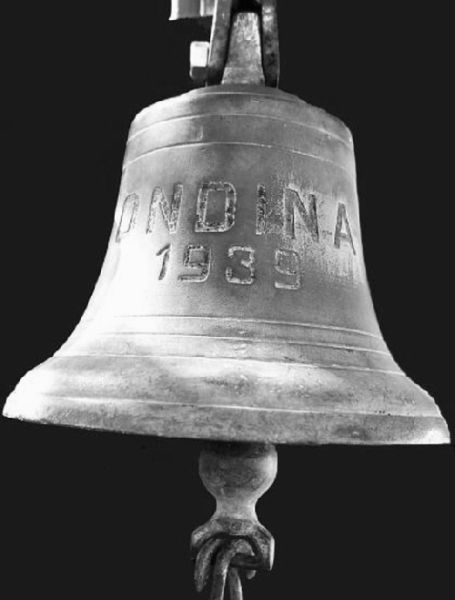 Ship`s bell of the Ondina. Source: Helderline.
Ship`s bell of the Ondina. Source: Helderline.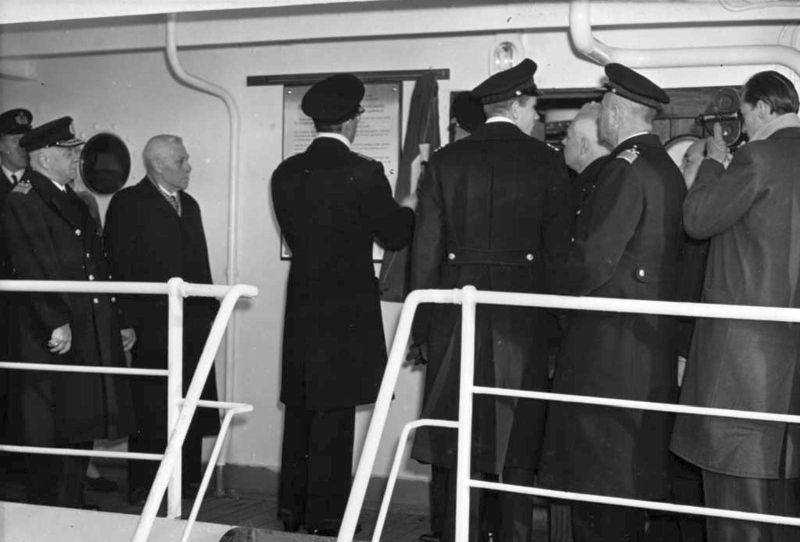 Prince Bernhard unveils the memorial plaque aboard the Ondina in 1948. Source: Maritiem digitaal.
Prince Bernhard unveils the memorial plaque aboard the Ondina in 1948. Source: Maritiem digitaal.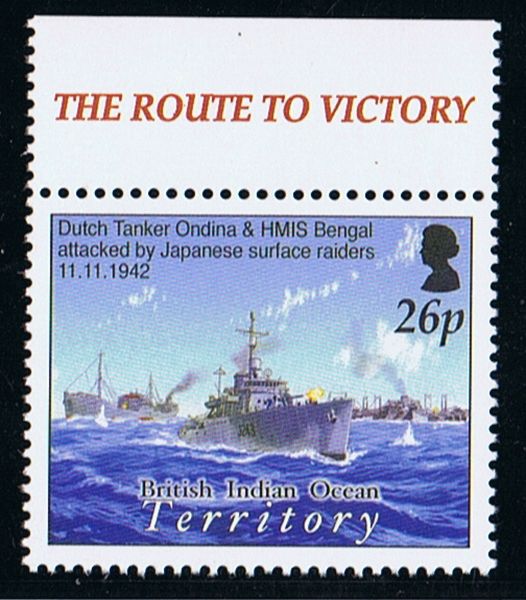 Stamp issued in honor of the heroic battle of Ondina and HMIS Bengal. Source: Shipstamps.
Stamp issued in honor of the heroic battle of Ondina and HMIS Bengal. Source: Shipstamps.Information
- Article by:
- Peter Kimenai
- Translated by:
- Fred Bolle
- Published on:
- 05-02-2013
- Last edit on:
- 05-10-2022
- Feedback?
- Send it!
Related sights
Related books
Sources
- BEZEMER, K.W.L., Verdreven doch niet verslagen, Uitgeversmaatschappij W. de Haan N.V., Hilversum, 1967.
- BOSSCHER, PH., M., De Koninklijke Marine in de Tweede Wereldoorlog deel 3, Uitgeverij T. Wever B.V., Franeker, 1990.
- MCCURTIE, F.E., Jane`s Fighting Ships of World War II, Military Press, New York, 1989.
- MÜNCHING, L.L. VON, Schepen van de Koninklijke Marine in de 2e wereldoorlog, De Alk bv, Alkmaar, 1978.
- VALKENIER, W.A.J.P., Op de valreep, Lanasta, Emmen, 2008.

